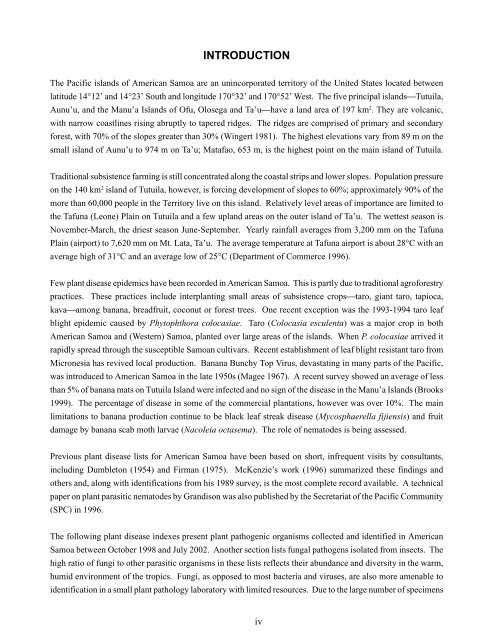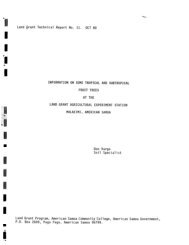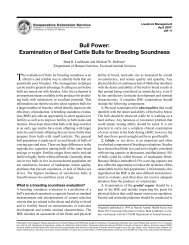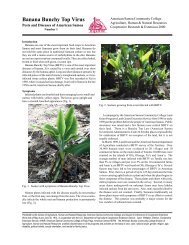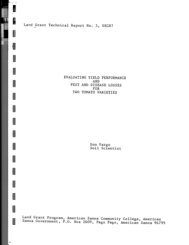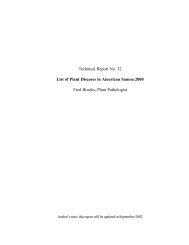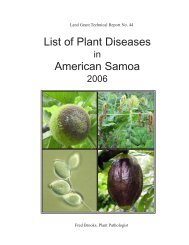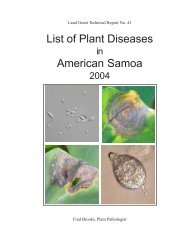99-02A intro - College of Tropical Agriculture and Human Resources ...
99-02A intro - College of Tropical Agriculture and Human Resources ...
99-02A intro - College of Tropical Agriculture and Human Resources ...
Create successful ePaper yourself
Turn your PDF publications into a flip-book with our unique Google optimized e-Paper software.
INTRODUCTION<br />
The Pacific isl<strong>and</strong>s <strong>of</strong> American Samoa are an unincorporated territory <strong>of</strong> the United States located between<br />
latitude 14°12’ <strong>and</strong> 14°23’ South <strong>and</strong> longitude 170°32’ <strong>and</strong> 170°52’ West. The five principal isl<strong>and</strong>s⎯Tutuila,<br />
Aunu’u, <strong>and</strong> the Manu’a Isl<strong>and</strong>s <strong>of</strong> Ofu, Olosega <strong>and</strong> Ta’u⎯have a l<strong>and</strong> area <strong>of</strong> 197 km2 . They are volcanic,<br />
with narrow coastlines rising abruptly to tapered ridges. The ridges are comprised <strong>of</strong> primary <strong>and</strong> secondary<br />
forest, with 70% <strong>of</strong> the slopes greater than 30% (Wingert 1981). The highest elevations vary from 89 m on the<br />
small isl<strong>and</strong> <strong>of</strong> Aunu’u to 974 m on Ta’u; Matafao, 653 m, is the highest point on the main isl<strong>and</strong> <strong>of</strong> Tutuila.<br />
Traditional subsistence farming is still concentrated along the coastal strips <strong>and</strong> lower slopes. Population pressure<br />
on the 140 km2 isl<strong>and</strong> <strong>of</strong> Tutuila, however, is forcing development <strong>of</strong> slopes to 60%; approximately 90% <strong>of</strong> the<br />
more than 60,000 people in the Territory live on this isl<strong>and</strong>. Relatively level areas <strong>of</strong> importance are limited to<br />
the Tafuna (Leone) Plain on Tutuila <strong>and</strong> a few upl<strong>and</strong> areas on the outer isl<strong>and</strong> <strong>of</strong> Ta’u. The wettest season is<br />
November-March, the driest season June-September. Yearly rainfall averages from 3,200 mm on the Tafuna<br />
Plain (airport) to 7,620 mm on Mt. Lata, Ta’u. The average temperature at Tafuna airport is about 28°C with an<br />
average high <strong>of</strong> 31°C <strong>and</strong> an average low <strong>of</strong> 25°C (Department <strong>of</strong> Commerce 1<strong>99</strong>6).<br />
Few plant disease epidemics have been recorded in American Samoa. This is partly due to traditional agr<strong>of</strong>orestry<br />
practices. These practices include interplanting small areas <strong>of</strong> subsistence crops⎯taro, giant taro, tapioca,<br />
kava⎯among banana, breadfruit, coconut or forest trees. One recent exception was the 1<strong>99</strong>3-1<strong>99</strong>4 taro leaf<br />
blight epidemic caused by Phytophthora colocasiae. Taro (Colocasia esculenta) was a major crop in both<br />
American Samoa <strong>and</strong> (Western) Samoa, planted over large areas <strong>of</strong> the isl<strong>and</strong>s. When P. colocasiae arrived it<br />
rapidly spread through the susceptible Samoan cultivars. Recent establishment <strong>of</strong> leaf blight resistant taro from<br />
Micronesia has revived local production. Banana Bunchy Top Virus, devastating in many parts <strong>of</strong> the Pacific,<br />
was <strong>intro</strong>duced to American Samoa in the late 1950s (Magee 1967). A recent survey showed an average <strong>of</strong> less<br />
than 5% <strong>of</strong> banana mats on Tutuila Isl<strong>and</strong> were infected <strong>and</strong> no sign <strong>of</strong> the disease in the Manu’a Isl<strong>and</strong>s (Brooks<br />
1<strong>99</strong>9). The percentage <strong>of</strong> disease in some <strong>of</strong> the commercial plantations, however was over 10%. The main<br />
limitations to banana production continue to be black leaf streak disease (Mycosphaerella fijiensis) <strong>and</strong> fruit<br />
damage by banana scab moth larvae (Nacoleia octasema). The role <strong>of</strong> nematodes is being assessed.<br />
Previous plant disease lists for American Samoa have been based on short, infrequent visits by consultants,<br />
including Dumbleton (1954) <strong>and</strong> Firman (1975). McKenzie’s work (1<strong>99</strong>6) summarized these findings <strong>and</strong><br />
others <strong>and</strong>, along with identifications from his 1989 survey, is the most complete record available. A technical<br />
paper on plant parasitic nematodes by Gr<strong>and</strong>ison was also published by the Secretariat <strong>of</strong> the Pacific Community<br />
(SPC) in 1<strong>99</strong>6.<br />
The following plant disease indexes present plant pathogenic organisms collected <strong>and</strong> identified in American<br />
Samoa between October 1<strong>99</strong>8 <strong>and</strong> July 2002. Another section lists fungal pathogens isolated from insects. The<br />
high ratio <strong>of</strong> fungi to other parasitic organisms in these lists reflects their abundance <strong>and</strong> diversity in the warm,<br />
humid environment <strong>of</strong> the tropics. Fungi, as opposed to most bacteria <strong>and</strong> viruses, are also more amenable to<br />
identification in a small plant pathology laboratory with limited resources. Due to the large number <strong>of</strong> specimens<br />
iv


